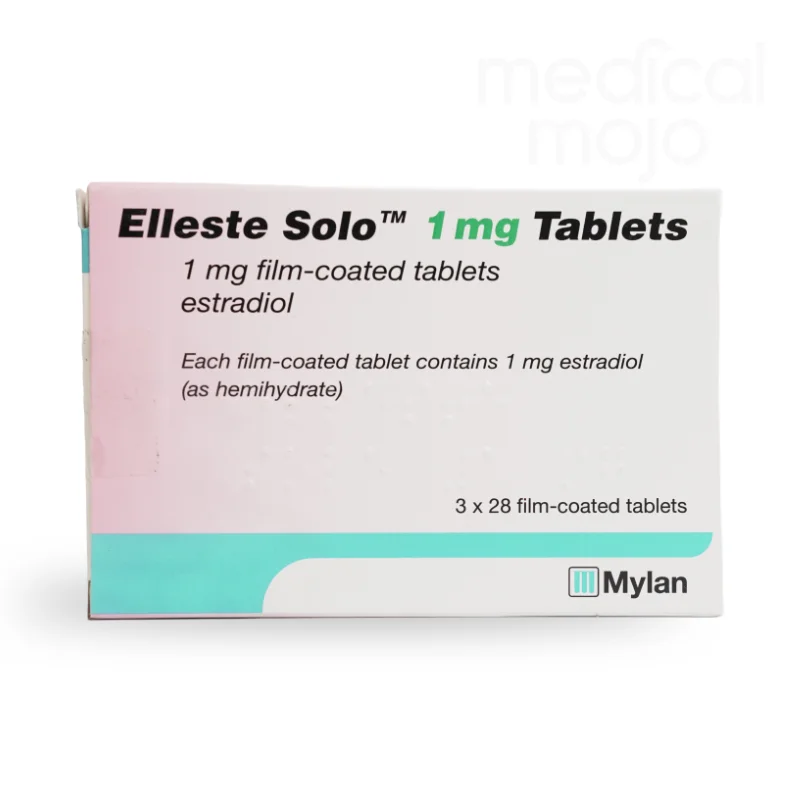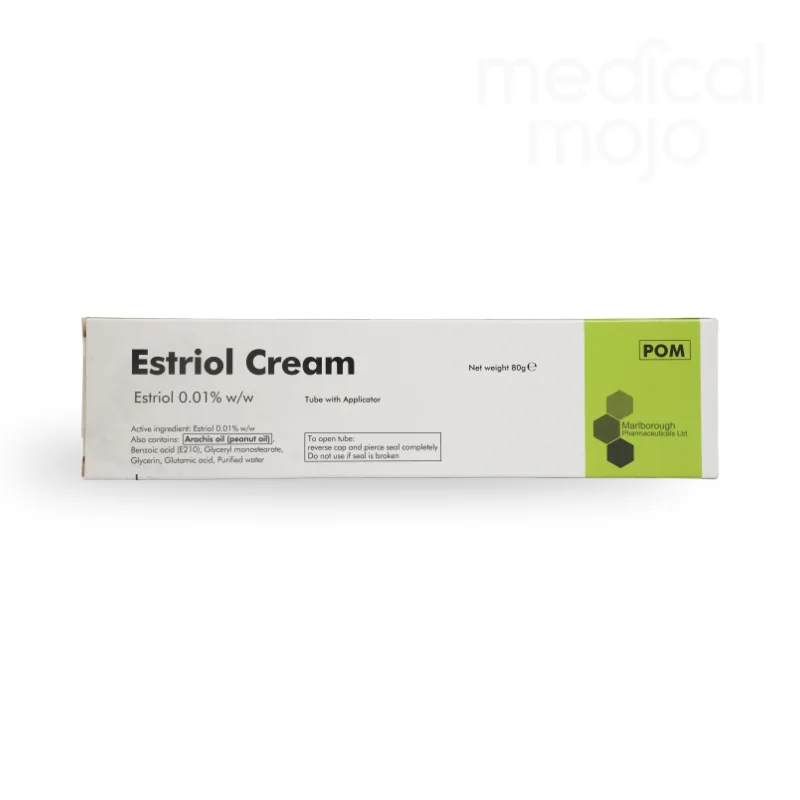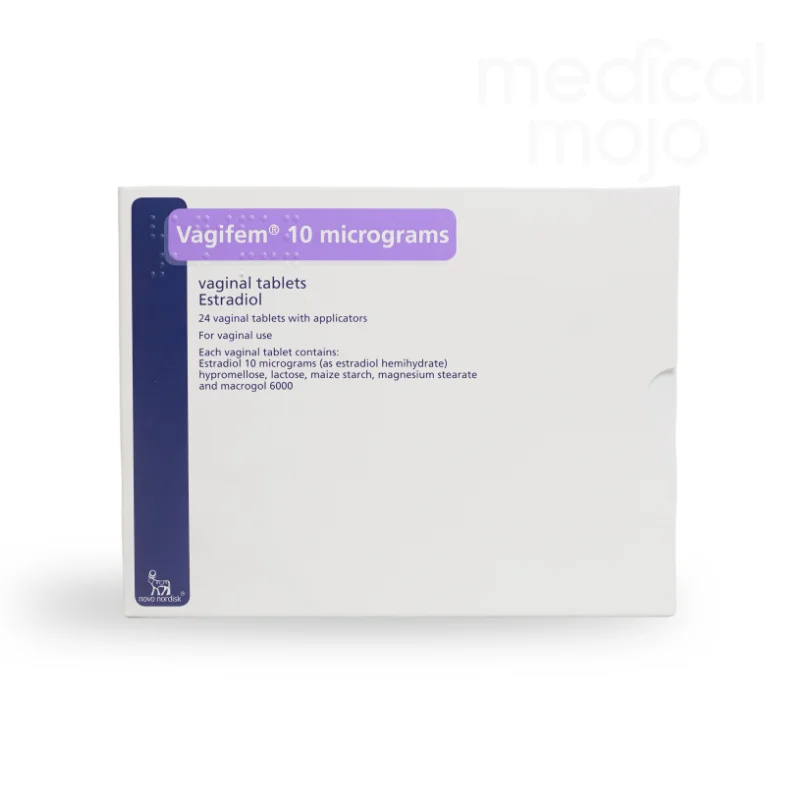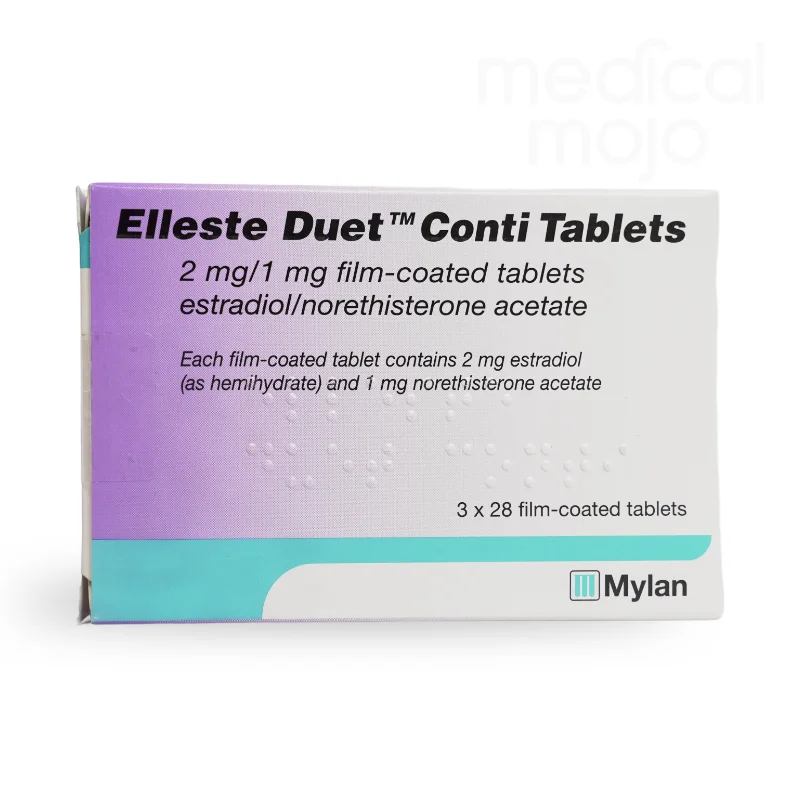What are Elleste Solo 1mg tablets?
Elleste Solo tablets are a type of hormone replacement therapy (HRT) that contain estradiol, a synthetic form of the hormone oestrogen. They are used to treat symptoms of menopause in women, such as hot flushes, night sweats, vaginal dryness, mood swings, and other discomforts caused by declining oestrogen levels. Elleste Solo is typically prescribed for women who have had a hysterectomy and therefore do not need a progestogen component in their HRT. The tablets are taken once daily, and the dosage is tailored to each woman’s needs based on her symptoms and medical history.
How does Elleste Solo 1mg work?
Elleste Solo works by replacing the oestrogen that the body no longer produces after menopause.
The active ingredient in Elleste Solo is estradiol hemihydrate, a form of oestrogen that mimics the natural hormone. By increasing oestrogen levels, Elleste Solo helps to alleviate menopausal symptoms such as hot flushes, night sweats, and vaginal dryness. Additionally, it helps maintain bone density, reducing the risk of osteoporosis and fractures in postmenopausal women.
Elleste Solo effectively addresses the decline in oestrogen, helping to balance hormone levels and manage the symptoms associated with menopause.
How do you use Elleste Solo 1mg?
Always take this medication exactly as directed by your doctor or pharmacist. If you're unsure about any instructions, consult them for clarification.
Your doctor will prescribe the lowest effective dose to manage your symptoms for the shortest time necessary. If you feel the dose is too strong or too weak, discuss it with your doctor.
- Starting Your Medication:
- If you're still having regular periods, begin taking your first tablet on the first day of bleeding.
- If your periods are irregular or have stopped, you can start immediately.
- Taking the Medication:
- Take one tablet daily, at a time that suits you, ideally at the same time each day.
- Swallow the tablets whole with water.
- Follow the direction of the arrows on the pack, taking one tablet each day until the pack is empty. All tablets are identical.
- The days of the week are marked on the strip to help you remember to take a tablet daily.
- Start a new strip the day after finishing the previous one.
- Switching from Another HRT:
- If you're switching from a different HRT, begin taking Elleste Solo after finishing your current pack.
- Follow any specific instructions from your doctor regarding the transition. If you're unsure, consult your doctor.
- Periods:
- If you haven't had a hysterectomy and are also taking a progestogen, you may experience a monthly bleed. Irregular bleeding may occur in the first few months. If it continues, inform your doctor.
- Surgery:
- If you’re scheduled for surgery, inform your surgeon that you’re taking Elleste Solo. You may need to stop taking it 4 to 6 weeks before the operation to reduce the risk of blood clots. Consult your doctor about when to resume the medication.
- Missed Dose:
- If you miss a dose, take it as soon as you remember, then continue with the next dose at the usual time.
- If it's been more than 12 hours since your missed dose, skip it and take the next one at the regular time. Don’t double the dose to make up for the missed one. You may experience breakthrough bleeding or spotting if you haven’t had a hysterectomy.
- Overdose:
- If you take more Elleste Solo than you should, it's unlikely to cause harm. You may experience nausea, vomiting, dizziness, drowsiness, or withdrawal bleeding. No treatment is typically necessary, but contact your doctor if you're concerned. The same applies if a child accidentally takes the medication.
Who should not use Elleste Solo 1mg?
Medical history and regular check-ups
The use of HRT carries certain risks that should be carefully considered before starting or continuing the treatment. If you have experienced premature menopause (due to ovarian failure or surgery), the risks may differ, so it's essential to discuss these with your doctor.
Before starting or restarting HRT, your doctor will ask about your personal and family medical history. A physical examination may also be recommended, which could include a breast exam and/or an internal examination.
Once you begin using Elleste Solo, it is important to have regular check-ups with your doctor (at least once a year). At each visit, discuss the ongoing benefits and risks of continuing treatment with Elleste Solo. Your doctor will also recommend regular breast screenings.
Do not take Elleste Solo if:
If any of the following apply to you, speak with your doctor before taking Elleste Solo:
- Breast cancer: if you have or have ever had it, or if you are suspected of having it.
- Cancer sensitive to oestrogens: such as cancer of the womb lining (endometrium), or if suspected.
- Unexplained vaginal bleeding.
- Excessive thickening of the womb lining (endometrial hyperplasia): if not being treated.
- Blood clot in a vein (thrombosis): such as deep vein thrombosis in the legs or pulmonary embolism in the lungs.
- Blood clotting disorder: such as protein C, protein S, or antithrombin deficiency.
- Recent or past arterial clot issues: such as heart attack, stroke, or angina.
- Liver disease: if you have had liver disease and your liver function has not returned to normal.
- Porphyria: a rare inherited blood problem.
- Allergic reaction: to estradiol hemihydrate or any of the other ingredients in this medication.
If any of these conditions appear while using Elleste Solo, stop taking it immediately and consult your doctor.
Special considerations with Elleste Solo:
Before starting treatment, inform your doctor if you've experienced any of the following conditions, as they may return or worsen during treatment. Regular monitoring and check-ups may be needed:
- Fibroids inside the womb
- Endometriosis or a history of excessive growth of the womb lining
- Increased risk of blood clots
- Increased risk of oestrogen-sensitive cancer (e.g., family history of breast cancer)
- High blood pressure
- Liver disorders, such as benign liver tumours
- Diabetes
- Gallstones
- Migraine or severe headaches
- Systemic lupus erythematosus (SLE), a disease of the immune system
- Epilepsy
- Asthma
- Otosclerosis, a disease affecting hearing and the eardrum
- High levels of fat in the blood (triglycerides)
- Fluid retention caused by heart or kidney problems
- Hereditary and acquired angioedema
When to stop taking Elleste Solo:
Stop using Elleste Solo and contact a doctor immediately if you experience any of the following:
- Symptoms of a serious condition from the "Do Not Take Elleste Solo" section.
- Yellowing of the skin or whites of the eyes (jaundice), which could indicate liver disease.
- Swollen face, tongue, or throat, difficulty swallowing, or hives, potentially signaling angioedema.
- A significant rise in blood pressure, with symptoms like headache, tiredness, or dizziness.
- Migraine-like headaches, especially if they occur for the first time.
- Signs of a blood clot, such as:
- Painful swelling and redness of the legs.
- Sudden chest pain.
- Difficulty breathing.
For more information, refer to the section on Blood Clots in a Vein (Thrombosis).
Additional note:
Elleste Solo is not a contraceptive. If it has been less than 12 months since your last period, or if you're under 50 years old, you may still need additional contraception to prevent pregnancy. Consult your doctor for advice.
HRT and cancer: FAQs
Endometrial hyperplasia and cancer of the womb lining
Taking oestrogen-only Hormone Replacement Therapy (HRT) increases the risk of excessive thickening of the womb lining (endometrial hyperplasia) and cancer of the womb lining (endometrial cancer).
To reduce this risk, if you still have your womb, your doctor will prescribe a progestogen to be taken in addition to the oestrogen for at least 12 days of each 28-day cycle. If you have had a hysterectomy (your womb has been removed), discuss with your doctor whether it is safe to take oestrogen-only HRT without adding a progestogen.
For women aged 50 to 65 who still have a womb and do not take HRT, about 5 in 1000 will develop endometrial cancer. However, in women of the same age who take oestrogen-only HRT, the number increases to between 10 and 60 in 1000, depending on the dose and duration of treatment.
The specific risk of endometrial cancer when using more than 2 mg of Elleste Solo along with a progestogen is currently unknown.
What is the risk of endometrial cancer with HRT?
Using estrogen-only HRT increases the risk of excessive thickening of the womb lining (endometrial hyperplasia) and endometrial cancer. To mitigate this risk, a progestogen is usually prescribed alongside estrogen for at least 12 days of each 28-day cycle, particularly if you still have your womb. If you have had a hysterectomy, consult your doctor to determine if you can safely use estrogen-only HRT.
For women aged 50 to 65 who do not use HRT, about 5 in 1000 are diagnosed with endometrial cancer. In contrast, those who use estrogen-only HRT face a higher risk, with 10 to 60 in 1000 women being diagnosed, depending on the dosage and duration of use.
What should I do if I experience unexpected bleeding while on HRT?
If you experience unexpected bleeding or spotting outside of your monthly withdrawal bleed while using Elleste Solo, especially if it:
- Persists beyond the first 6 months,
- Starts after more than 6 months of use,
- Continues after you’ve stopped using Elleste Solo,
You should consult your doctor as soon as possible.
Does HRT increase the risk of breast cancer?
Evidence shows that using combined estrogen-progestogen or estrogen-only HRT increases the risk of breast cancer. This extra risk becomes noticeable within 3 years of use and may persist for 10 years or more after stopping HRT, especially if used for more than 5 years.
For example, in women aged 50 to 54 not using HRT, 13 to 17 in 1000 may be diagnosed with breast cancer over a 5-year period. For those on estrogen-only HRT, the risk increases to 16-17 in 1000, and for those on combined HRT, the risk rises to 21 in 1000.
How can I monitor for breast cancer while on HRT?
Regularly check your breasts for any changes such as dimpling of the skin, changes in the nipple, or any lumps you can see or feel. It’s also important to participate in mammography screening programs as advised by your doctor. When having a mammogram, inform the healthcare provider that you are using HRT, as it can increase breast density and affect the mammogram results.
Does HRT increase the risk of ovarian cancer?
There is a slightly increased risk of ovarian cancer with the use of both estrogen-only and combined estrogen-progestogen HRT. For women aged 50 to 54 who are not using HRT, about 2 in 2000 will be diagnosed with ovarian cancer over 5 years. This increases to about 3 in 2000 for women using HRT.
HRT and circulation: FAQs
How does HRT affect the risk of blood clots?
The risk of blood clots in the veins (thrombosis) is 1.3 to 3 times higher in HRT users compared to non-users, particularly during the first year of use. Blood clots can be serious, especially if they travel to the lungs, potentially causing chest pain, breathlessness, fainting, or even death.
In women in their 50s not using HRT, about 4 to 7 in 1000 might develop a blood clot over 5 years. This increases to 9 to 12 in 1000 for women using combined HRT, and to 5 to 8 in 1000 for those using estrogen-only HRT after a hysterectomy.
Does HRT affect heart disease risk?
HRT does not prevent heart attacks. Women over 60 using combined estrogen-progestogen HRT are slightly more likely to develop heart disease compared to non-users. However, for women who have had a hysterectomy and are using estrogen-only therapy, there is no increased risk of heart disease.
Does HRT increase the risk of stroke?
Yes, the risk of stroke is about 1.5 times higher in HRT users compared to non-users. For women in their 50s not using HRT, 8 in 1000 are expected to have a stroke over 5 years. This number increases to 11 in 1000 for those using HRT.
Other FAQs
Does HRT affect memory?
HRT does not prevent memory loss, and there is some evidence that starting HRT after age 65 may increase the risk of memory loss. Consult your doctor for advice.
What should I know about Elleste Solo and pregnancy?
Oestrogel is intended for use in postmenopausal women only. If you become pregnant, stop using Oestrogel and contact your doctor.
What are the side effects with Elleste Solo 1mg?
Like all medicines, Elleste Solo can cause side effects, although not everyone will experience them.
Diseases reported more often in women using HRT:
- Breast cancer
- Abnormal growth or cancer of the lining of the womb (endometrial hyperplasia or cancer)
- Ovarian cancer
- Blood clots in the veins of the legs or lungs (venous thromboembolism)
- Heart disease
- Stroke
- Possible memory loss if HRT is started after age 65
Side effects associated with Elleste Solo
The frequency of side effects is categorized as follows:
- Very common: May affect more than 1 in 10 people
- Common: May affect up to 1 in 10 people
- Uncommon: May affect up to 1 in 100 people
- Rare: May affect up to 1 in 1,000 people
- Very rare: May affect up to 1 in 10,000 people
- Not known: Frequency cannot be estimated from the available data
Common side effects:
- Nausea
- Abdominal pain
- Headache
- Increase in size of leiomyoma (benign tumor of the womb)
- Breakthrough bleeding
- Irregular menstruation
- Uterine/vaginal bleeding, including spotting
- Weight changes
- Swelling of the legs (oedema)
- Breast tenderness and enlargement
- Mood changes, including anxiety and depressed mood
- Changes in sex drive
- Rash and itching
Uncommon side effects:
- Indigestion, vomiting, flatulence
- Gallstones and gallbladder disease
- Dizziness, migraine
- Vaginal thrush
- Hypersensitivity reactions
- Visual impairment
- Palpitations
- Hives (urticaria)
- Breast pain
- Painful reddish skin nodules (erythema nodosum)
Rare side effects:
- Increase in body and facial hair
- Contact lens intolerance
- Acne
- Muscle cramps
- Pre-menstrual syndrome (PMS)
- Painful periods (dysmenorrhoea)
- Vaginal discharge
Other side effects reported with Estradiol treatment (frequency unknown):
- Breast cancer, benign or malignant tumors related to estrogen levels
- Worsening of epilepsy or muscle twitches (chorea)
- Stroke, blood clots in the arteries (arterial thromboembolism), angina, heart attack
- Blood clots in the legs or lungs (venous thromboembolism or pulmonary embolism)
- Pancreatitis in women with high blood fats (hypertriglyceridemia)
- Gastroesophageal reflux disease (GERD)
- Abnormal liver function, jaundice
- Swelling around the face and throat, causing difficulty breathing (angioedema)
- Rash with target-shaped redness or sores (erythema multiforme)
- Purplish patches or spots on the skin (vascular purpura)
- Skin discolouration, especially on the face or neck (“pregnancy patches” or chloasma)
- Urinary incontinence
- Painful or lumpy breasts (fibrocystic breast disease)
Reporting side effects:
If you experience any side effects, consult your doctor, pharmacist, or nurse. This includes any side effects not listed here. You can also report side effects directly through the Yellow Card Scheme at www.mhra.gov.uk/yellowcard or by searching for "MHRA Yellow Card" in the Google Play or Apple App Store. Reporting side effects can help provide more information on the safety of this medicine.











